Imagine a time when bugs crawling and buzzing through the air didn’t measure in inches, but feet!
Today, some of the world’s most important contributors are also the smallest. Insects might be a nuisance to us when they chew on leaves in our garden, bore holes into our fruit, or buzz around us relentlessly at a picnic, but without them, we would be missing out on a lot of the Earth’s joys.
There are over ten quintillion insects alive today, consisting of over one million species (and growing each year!) worldwide. This makes up more than 70 percent of the species on the planet. In the U.S., there are four main categories insects fall into. These are:
Most these insects are small and make their impacts felt by their large numbers, but what are the mega bugs in the world? Today, mega bugs from butterflies, to wasps, and beetles are alive. They’re giant insects of the modern world!
But what about those ancient bugs we just mentioned that didn’t measure in inches but feet? 300 million years ago, conditions on Earth were just right to create an era of giants insects and invertebrates.
After exploring the largest insects alive in the world today, we’ll dive into the giants that were the largest insects and invertebrates to ever to roam the Earth. From a dragonfly with a wingspan of 30 inches to a millipede that could grow to 7 feet in length, you won’t want to miss this collection of giant insects and invertebrates from the past!
The Giant Insects of Today: The Biggest Bugs in the Modern World
Before we analyze the largest insects to ever live, we need to take a look at just how big the largest insects are today. We’ll detail giant insects from beetles, to wasps, and beyond!
The Largest Beetle: The Titan Beetles (Titanus giganteus)
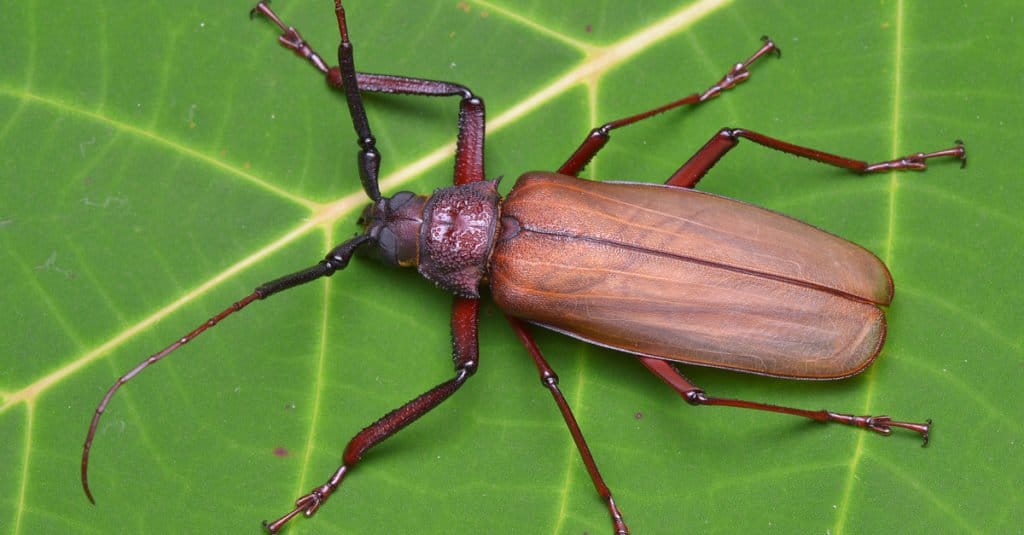
The Titan Beetle must leap off a tree in order to fly.
©SIMON SHIM/Shutterstock.com
The titan beetle is the largest beetle in the world when measuring body length. This beetle likes the rain forests of the Amazon. They can grow up to 6.6 inches long and their jaw is strong enough to tear at human flesh and snap small twigs about the size of a pencil. They use their strong jaw to defend against predators.
Scientists have never found a titan beetle larva, although they have found holes in dead trees that they believe they created by these larvae. The larvae of titan beetle can reach up to one foot in length and be as wide as two inches, judging by the size of the boreholes.
A titan beetle flies around until it finds a mate and reproduces just as the large atlas moth does when in its adult phase. It appears that no pupae have ever been found. They may reach maturity underground, in the roots and branches of plants. Before they pupate, they need to grow to a large enough size.
Bright lights attract these beetles after dark. French Guiana uses mercury-vapor lamps to attract male titan beetles. This region has an ecotourism industry built upon providing sightings and specimens of these beetles.
The Longest Insect: Stick Insects that Can Reach a Foot in Length!
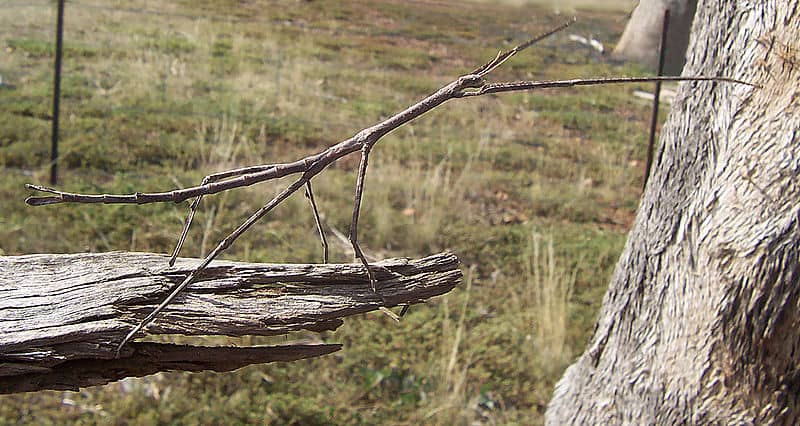
Some stick insects can reach up to a foot in length!
©Fir0002 / Creative Commons – Original
Phasmatodea is the world’s longest insect. They have evolved a bizarre shape to hide among branches, twigs, and foliage from predators. Insects that reach the longest lengths belong to the genus Phobaeticus, including the species Phobaeticus serratipes and Phobaeticus chani, which previously held the record for long stick insects. According to Guinness World Records, a specimen of Phryganistria chinensis, discovered in China in 2016, holds the world record for the longest insect.
There are more than 3,000 species of stick insects in the world, divided into five families, and over 300 species are found in China across four families. Stick insects are long and thin with ‘nodes’ that resemble bamboo plants. Additionally, each leg seems to look like a bamboo branch. Chinese call them bamboo-node insects because of this characteristic.
Compared to its Chinese name, the Greek name for the stick insect, phasma, implies something more imaginative: it translates as “phantom.” Asia has the most species of stick insects in the world. Some species have unusual colors, exaggerated colors, and are large. A lot of insect collectors and lovers aspire to own one.
The Heaviest Insects: Giant Wetas (Deinacrida heteracantha)
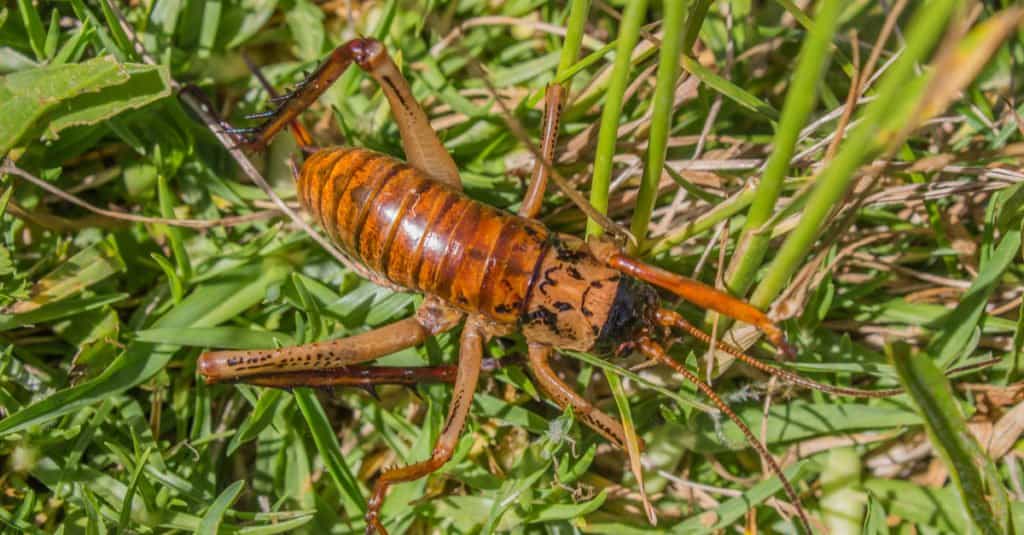
The Giant Weta is the largest flightless cricket.
©Viktor Hejna/Shutterstock.com
New Zealand’s remote location and long history from other land masses led to fewer mammal species than other continents. The result was that mammals like rodents weren’t present to scavenge. In their place, wetas evolved to large sizes.
A giant weta can weigh more than 70 grams (about 2 ounces), making it one of the heaviest insects globally. They can weigh considerably more than a sparrow. In addition to their long bodies, they have legs and antennae that measure about 4 inches long. They are excellent examples of island gigantism since they can only be found on islands.
Wetas are the heaviest insects on record. A weta can weigh up to 2.5 ounces, though most don’t reach that size. In 2011, Smithsonian researcher Mark Moffett discovered a particularly large giant weta while visiting Little Barrier Island in New Zealand. This photo of Moffett feeding a carrot to the enormous insect went viral. According to a New Zealand insect expert, feeding insects carrots is quite common.
Unfortunately, after the arrival of colonists in New Zealand rodents decimated the population of wetas. Though once prevalent across New Zealand’s northern island, the giant weta became extinct on mainland New Zealand in the 1960s. Today, giant wetas can be found only on Little Barrier Island, about 50 miles northeast of Auckland.
The Largest Wasp: Tarantula Hawks (Pepsis pulszkyi)
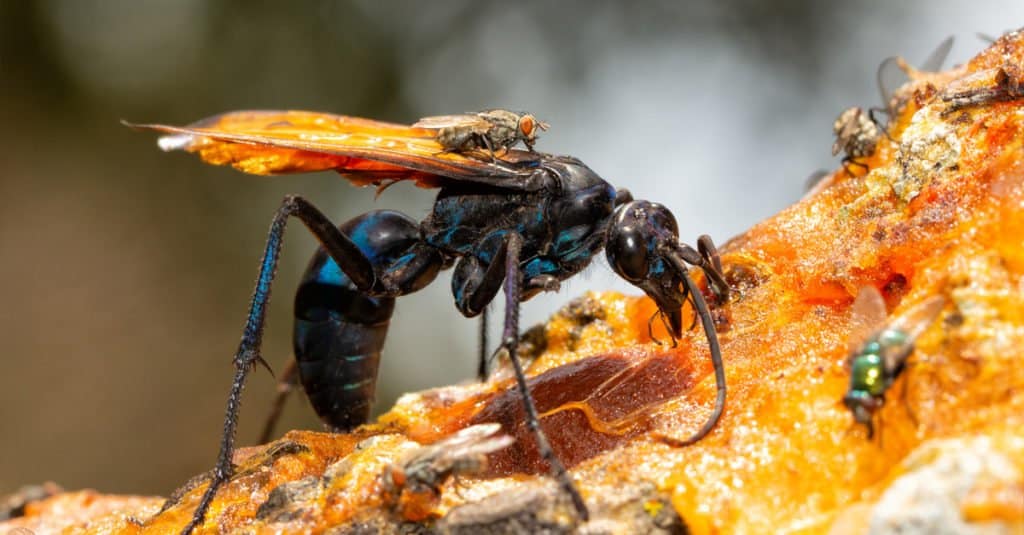
Tarantula Hawks are such dangerous wasps that they are often seen consuming a tarantula spider.
©Sari ONeal/Shutterstock.com
Tarantula Hawks are members of the wasp genera Pepsis and Hemipepsis, which measure around two inches long. They are so large and vicious that they hunt tarantulas as a source of food. The tarantula hawk will lay eggs during the spider’s life so that the young can eat it when it hatches. A tarantula hawk‘s wingspan is 4.5 inches, and it can grow up to 2.7 inches long. This makes Tarantula Hawks the largest wasp in the world.
There are more than 250 species of Pepsis in South America and 15 in the United States, with at least nine occurring in deserts. Tarantula hawks appear wherever tarantulas are found. Tarantula hawks are eaten only by roadrunners and nesting wasps.
A Nearly One Foot Wingspan Butterfly: The Queen’s Alexandra’s Birdwing
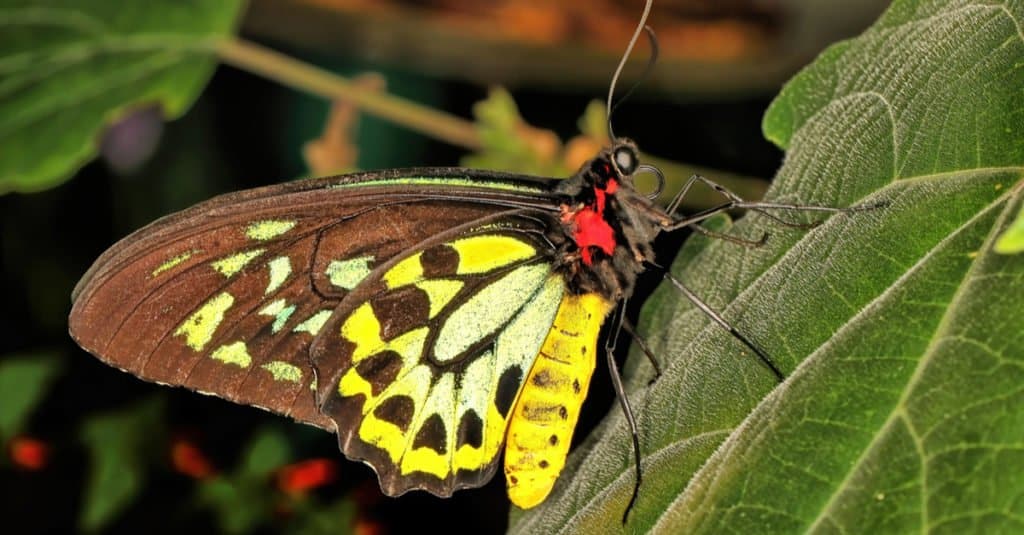
Queen Alexandra is the biggest
butterfly
with a wingspan on 11 inches.
©Russell Marshall/Shutterstock.com
The Queen Alexandra’s Birdwing butterfly has a wingspan that reaches 11 inches wide, making it the largest butterfly in the world. Tropical butterflies like this one live in lowland coastal rainforests in New Guinea. An endangered butterfly, this one is huge. Plantations of oil palm are clearing rainforest habitat, reducing the habitat of this species.
Females are larger, have different patterns and coloration on their wings, and are different from males in size, color, and shape. Compared to the male, the female has longer, brown wings (with white markings) and a cream-colored body with tufts of red hair on the chest. Females tend to be smaller, very brightly colored (wings and body are green and blue), and patterned.
Despite its localized distribution, Queen Alexandra’s Birdwing is extremely rare. There is just one small strip of lowland coastal rainforest (east of the Owen Stanley Mountains) where this scarce (and endangered) butterfly can be found. A tropical lowland forest is home to them. The adult lifespan is about three months.
Giant Insects of the Past: Prehistoric Insects that Grew to Incredible Sizes!
300 million years ago, the world was a much different place than today! It was an era before dinosaurs and some unusual animals — by today’s standards — were the largest on Earth. Specifically, invertebrates were among the largest creatures in the world.
The explosion of giant insects began during the Carboniferous period, which lasted from 359 million to about 299 million years ago. At the time, oxygen levels were significantly higher than found on Earth today, which fueled gigantism across a number of invertebrates.
In addition, insects and other bugs didn’t yet face the threat from birds, which had not yet evolved to roam the skies as predator capable of feating on the largest insects in the world. As birds began appearing roughly 150 million years ago, insect sizes in the fossil record began plummeting.
Just how big did prehistoric giant insects grow? Below we’ll detail some species that would put today’s mega bugs to shame!
Meganeura: A Dragonfly with a 30 Inch Wingspan!
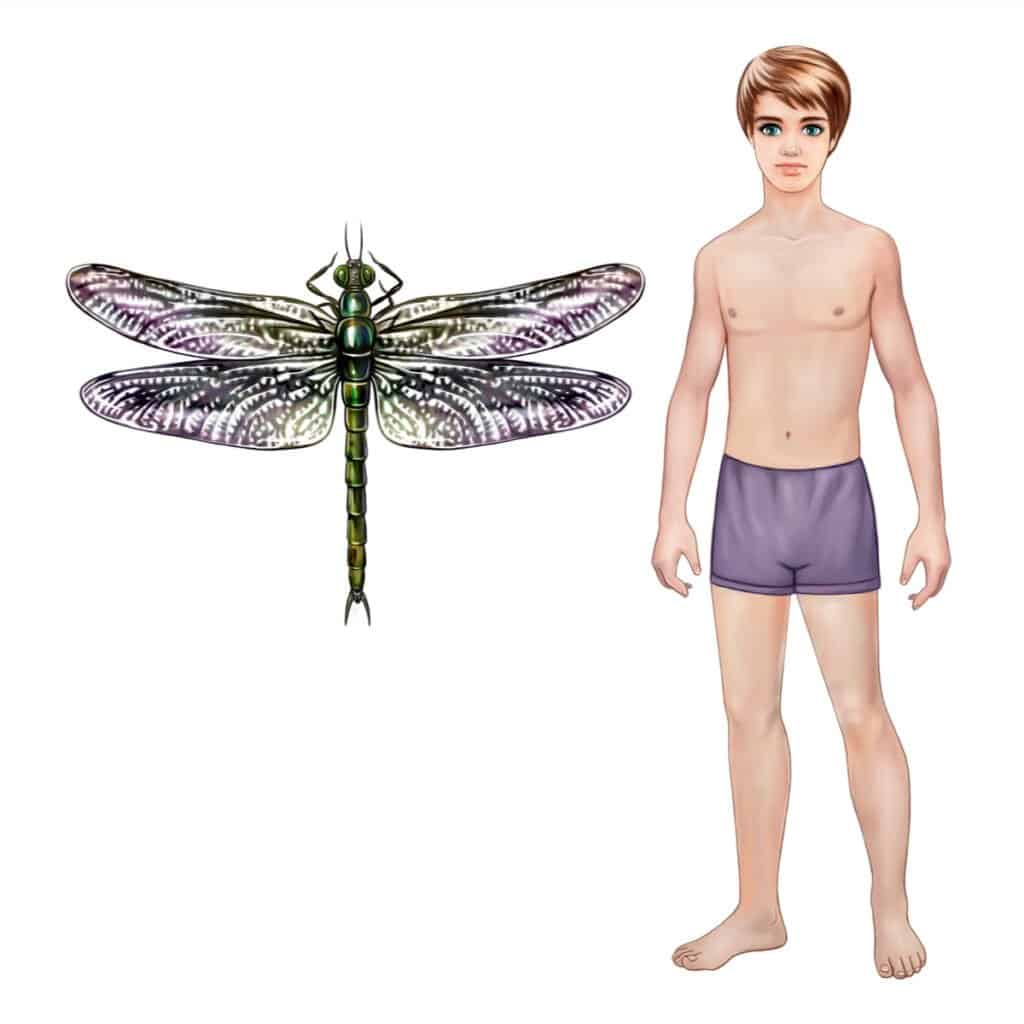
A comparison of a dragonfly from
Meganeuracompared to a human
©Liliya Butenko/Shutterstock.com
The largest dragonfly in the world today is Tetracanthagyna plagiata. Its wingspan can measure up to 7 inches and it weighs 7 grams (.015 pounds). By today’s standards, that makes Tetracanthagyna plagiata a giant, but by the standards of past mega bugs today’s largest dragonfly is tiny.
That’s because the skies of 300 million years ago were rules by Meganeura, a genus of dragonflies whose wingspans could reach up to 30 inches across! With body sizes that could reach up to 150 grams (1/3 a pound), Meganeura was about 21 times the size of today’s largest dragonflies!
Pulmonoscorpius: The two foot long scorpion!
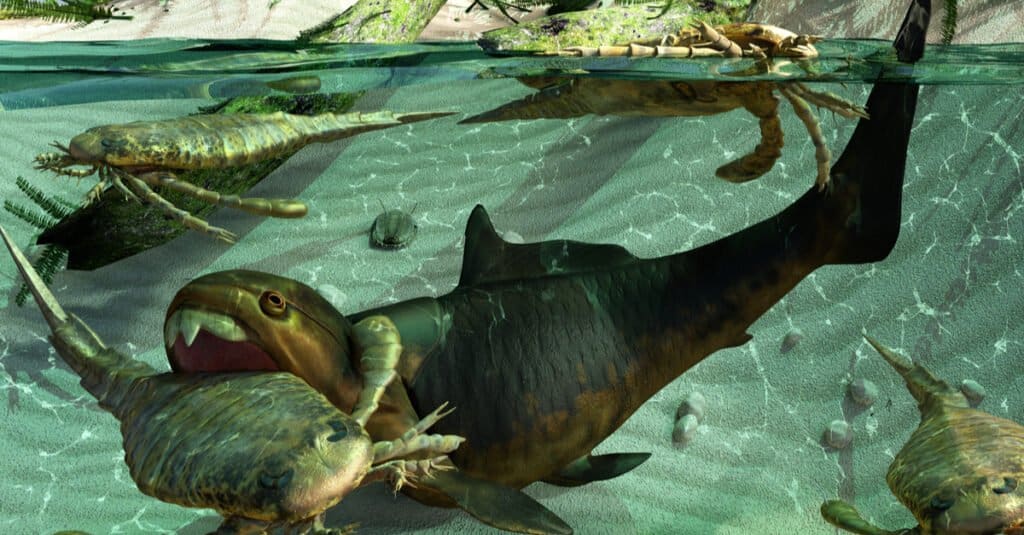
Land
scorpions
reached 28 inches in the Carboniferous period, but sea scorpion reached even greater size!
©Aunt Spray/Shutterstock.com
Scorpions aren’t insects, but rather a member of the arachnids. However, if we’re looking at mega bugs of the past we need to include a look at Pulmonoscorpius, a scorpion that could reach up to 28 inches in length and live on land!
For comparison, the largest scorpion alive today is the giant forest scorpion, which reaches just 9 inches. Ancient scorpions that lived below the seas got even larger. The giant sea scorpion which lived during this era reached more than 8 feet in length!
The largest arthropod: An extinct 7 foot long millipede!

Imagine looking into your backyard to discover a 7 foot long
millipede
in the grass!
©FABRIZIO CONTE/Shutterstock.com
Once again, arthropods are different than insects, but they were truly an ancient mega bug that would be shocking by today’s standards!
Arthropleura was a genus similar to today’s millipedes. The big difference is that by today’s standards, they were positively super-sized, with one species (A. armata) measuring seven feet in length. Put another way, it would be longer than a human laying next to it! The largest millipede in the world today is a mere fraction the size of A. armata. The giant African millipede measures a maximum of 11 inches in length.
Like many other giant bugs of the past, the Arthropleura genus went extinct at the end of the Carboniferous era. Climate change led to a dramatically different world where rainforests were replaced by deserts and
The photo featured at the top of this post is © Aunt Spray/Shutterstock.com
Thank you for reading! Have some feedback for us? Contact the AZ Animals editorial team.







